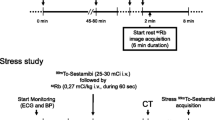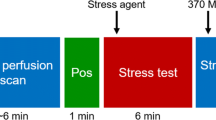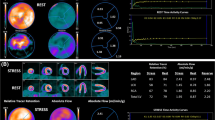Abstract
Purpose
Myocardial perfusion imaging with 82Rb PET allows for ECG-gated studies to be obtained early after radiotracer injection, capturing ventricular function close to peak pharmacologic action of dipyridamole. This is different from gated SPECT and may potentially provide additional diagnostic information. We sought to identify potential correlates of the PET-derived ejection fraction response to vasodilator stress.
Methods
One hundred ten consecutive patients undergoing 82Rb PET myocardial perfusion imaging during evaluation for coronary artery disease were included. Using a GE Discovery STRx PET-CT scanner, ECG-gated images (eight bins) were obtained at rest and 4 min after dipyridamole infusion, 90 s after infusion of 1,480–2,220 MBq of 82Rb. Summed rest, stress, and difference scores (SRS, SSS, and SDS) were determined using a five-point scoring system and 20-segment model. Ejection fraction was calculated using automated QGS software.
Results
Significant reversibility (SDS ≥ 4) was found in 23 patients (21%). Mean LVEF in all patients was 47 ± 13% at rest and 53 ± 13% during dipyridamole. LVEF increased in 89 patients, and decreased in 17 patients during vasodilation. The change in LVEF was inversely correlated with SDS (r = −0.26; p = 0.007). Additionally, it was inversely correlated with resting LVEF (r = −0.20; p = 0.03) and SSS (r = −0.25; p = 0.009). No significant correlations were observed with SRS, heart rate, blood pressure, age, hypertension, hypercholesterolemia, or pretest likelihood of disease. At multivariate regression analysis, SDS was an independent predictor of the change in LVEF.
Conclusions
Gated 82Rb PET during pharmacologic stress allows for assessment of the functional response to vasodilation. The magnitude of LVEF increase is determined by stress perfusion/reversible perfusion defects. Functional response to hyperemia may thus be incorporated in future evaluations of diagnostic and prognostic algorithms based on 82Rb PET.



Similar content being viewed by others
References
Stewart RE, Schwaiger M, Molina E, Popma J, Gacioch GM, Kalus M, et al. Comparison of rubidium-82 positron emission tomography and thallium-201 SPECT imaging for detection of coronary artery disease. Am J Cardiol 1991;67 16:1303–10.
Stewart RE, Popma J, Gacioch GM, Kalus M, Squicciarini S, al-Aouar Z, et al. Comparison of thallium-201 SPECT redistribution patterns and rubidium-82 PET rest-stress myocardial blood flow imaging. Int J Card Imaging 1994;10 1:15–23.
MacIntyre WJ, Go RT, King JL, Cook SA, Neumann DR, Saha GB, et al. Clinical outcome of cardiac patients with negative thallium-201 SPECT and positive rubidium-82 PET myocardial perfusion imaging. J Nucl Med 1993;34 3:400–04.
Marwick TH, Go RT, MacIntyre WJ, Saha GB, Underwood DA. Myocardial perfusion imaging with positron emission tomography and single photon emission computed tomography: frequency and causes of disparate results. Eur Heart J 1991;12 10:1064–69.
Bateman TM, Heller GV, McGhie AI, Friedman JD, Case JA, Bryngelson JR, et al. Diagnostic accuracy of rest/stress ECG-gated Rb-82 myocardial perfusion PET: comparison with ECG-gated Tc-99 m sestamibi SPECT. J Nucl Cardiol 2006;13 1:24–33.
Marwick TH, Zuchowski C, Lauer MS, Secknus MA, Williams J, Lytle BW. Functional status and quality of life in patients with heart failure undergoing coronary bypass surgery after assessment of myocardial viability. J Am Coll Cardiol 1999;33 3:750–8.
Marwick TH, Shan K, Patel S, Go RT, Lauer MS. Incremental value of ribidum-82 positron emission tomography for prognostic assessment of known or suspected coronary artery disease. Am J Cardiol 1997;80 7:865–70.
Chow BJ, Wong JW, Yoshinaga K, Ruddy TD, Williams K, deKemp RA, et al. Prognostic significance of dipyridamole-induced ST depression in patients with normal 82Rb PET myocardial perfusion imaging. J Nucl Med 2005;46 7:1095–101.
Yoshinaga K, Chow BJ, Williams K, Chen L, deKemp RA, Garrard L, et al. What is the prognostic value of myocardial perfusion imaging using rubidium-82 positron emission tomography? J Am Coll Cardiol 2006;48 5:1029–39.
DePuey EG, Corbett JR, Friedman JD, Goldstein RA, Hansen DL, Henzlova MJ, et al. ASNC imaging guidelines for nuclear cardiology procedures: a report of the American Society of Nuclear Cardiology Quality Assurance Committee. June 2006. Available at http://www.asnc.org/section_73.cfm.
Schaefer WM, Lipke CS, Nowak B, Kaiser HJ, Buecker A, Krombach GA, et al. Validation of an evaluation routine for left ventricular volumes, ejection fraction and wall motion from gated cardiac FDG PET: a comparison with cardiac magnetic resonance imaging. Eur J Nucl Med Mol Imaging 2003;30 4:545–53.
Hattori N, Bengel FM, Mehilli J, Odaka K, Ishii K, Schwaiger M, et al. Global and regional functional measurements with gated FDG PET in comparison with left ventriculography. Eur J Nucl Med Mol Imaging 2001;28 2:221–9.
Hickey KT, Sciacca RR, Bokhari S, Rodriguez O, Chou RL, Faber TL, et al. Assessment of cardiac wall motion and ejection fraction with gated PET using N-13 ammonia. Clin Nuc Med 2004;29 4:243–8.
Smanio PE, Watson DD, Segalla DL, Vinson EL, Smith WH, Beller GA. Value of gating technetium-99 m sestamibi single-photon emission computed tomographic imaging. J Am Coll Cardiol 1997;30 7:1687–92.
Taillefer R, DePuey EG, Udelson JE, Beller GA, Latour Y, Reeves F. Comparative diagnostic accuracy of Tl-201 and Tc-99 m sestamibi SPECT imaging (perfusion and ECG-gated SPECT) in detecting coronary artery disease in women. J Am Coll Cardiol 1997;29 1:69–77.
Sharir T, Germano G, Kavanagh PB, Lai S, Cohen I, Lewin HC, et al. Incremental prognostic value of post-stress left ventricular ejection fraction and volume by gated myocardial perfusion single photon emission computed tomography. Circulation 1999;100 10:1035–42.
Travin MI, Heller GV, Johnson LL, Katten D, Ahlberg AW, Isasi CR, et al. The prognostic value of ECG-gated SPECT imaging in patients undergoing stress Tc-99 m sestamibi myocardial perfusion imaging. J Nucl Cardiol 2004;11 3:253–62.
Emmett L, Iwanochko RM, Freeman MR, Barolet A, Lee DS, Husain M. Reversible regional wall motion abnormalities on exercise technetium-99 m-gated cardiac single photon emission computed tomography predict high-grade angiographic stenoses. J Am Coll Cardiol 2002;39 6:991–8.
Johnson LL, Verdesca SA, Aude WY, Xavier RC, Nott LT, Campanella MW, et al. Postischemic stunning can affect left ventricular ejection fraction and regional wall motion on post-stress gated sestamibi tomograms. J Am Coll Cardiol 1997;30 7:1641–8.
Petix NR, Sestini S, Marcucci G, Coppola A, Arena A, Nassi F, et al. Can the reversible regional wall motion abnormalities on stress gated Tc-99 m sestamibi SPECT predict a future cardiac event? J Nucl Cardiol 2005;12 1:20–31.
Petix NR, Sestini S, Coppola A, Marcucci G, Nassi F, Taiti A, et al. Prognostic value of combined perfusion and function by stress technetium-99 m sestamibi gated SPECT myocardial perfusion imaging in patients with suspected or known coronary artery disease. Am J Cardiol 2005;95 11:1351–7.
Hunt GU, Lee KW, Chen CP, Yang KT, Lin WY. Worsening of left ventricular ejection fraction induced by dipyridamole on Tl-201 gated myocardial perfusion imaging predicts significant coronary artery disease. J Nucl Cardiol 2006;13 2:225–32.
Druz RS, Akinboboye OA, Grimson R, Nichols KJ, Reichek N. Postischemic stunning after adenosine vasodilator stress. J Nucl Cardiol 2004;11 5:534–41.
Dorbala S, Vangala D, Sampson U, Limaye A, Kwong R, DiCarli MF. Value of vasodilator left ventricular ejection fraction reserve in evaluating the magnitude of myocardium at risk and the extent of angiographic coronary artery disease: a 82-Rb PET/CT study. J Nucl Med 2007;48 3:349–58.
Cortigiani L, Bigi R, Sicari R, Landi P, Bovenzi F, Picano E. Prognostic value of pharmacological stress echocardiography in diabetic and nondiabetic patients with known or suspected coronary artery disease. J Am Coll Cardiol 2006;47 3:605–10.
Radovanovic MR, Pokrajcic ZV, Radovanoic N, Beleslin B, Marinokovic J, Stankovic G, et al. Predictive value of biphasic response during dipyridamole echocardiography test in the low risk group of patients after acute myocardial infarction. J Am Soc Echocardiogr 2005;18 12:1355–61.
Sicari R, Palindas A, Pasanisi EG, Venneri L, Picano E. Long-term survival of patients with chest pain syndrome and angiographically normal or near-normal coronary arteries: the additional prognostic value of dipyridamole echocardiography test (DET). Eur Heart J 2005;26 20:2136–41.
Porenta G, Cherry S, Czernin J, Brunken R, Kuhle W, Hashimoto T, et al. Noninvasive determination of myocardial blood flow, oxygen consumption and efficiency in normal humans by carbon-11 acetate positron emission tomography imaging. Eur J Nuc Med Mol Imaging 1999;26 11:1465–574.
Hachamovitch R, Hayes SW, Friedman JD, Cohen I, Berman DS. Comparison of the short-term survival benefit associated with revascularization compared with medical therapy in patients with no prior coronary artery disease undergoing stress myocardial perfusion single photon emission computed tomography. Circulation 2003;107 23:2900–7.
Rozanski A, Gransar H, Wong ND, Shaw LJ, Miranda-Peats R, Polk D, et al. Clinical outcomes after both coronary calcium scanning and exercise myocardial perfusion scintigraphy. J Am Coll Cardiol 2007;49 12:1352–61.
Author information
Authors and Affiliations
Corresponding author
Rights and permissions
About this article
Cite this article
Brown, T.L.Y., Merrill, J., Volokh, L. et al. Determinants of the response of left ventricular ejection fraction to vasodilator stress in electrocardiographically gated 82rubidium myocardial perfusion PET. Eur J Nucl Med Mol Imaging 35, 336–342 (2008). https://doi.org/10.1007/s00259-007-0603-2
Received:
Accepted:
Published:
Issue Date:
DOI: https://doi.org/10.1007/s00259-007-0603-2




